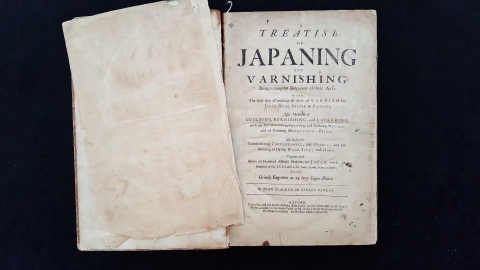A Treatise of Japanning and Varnishing
A treatise of japaning [sic] and varnishing : being a compleat discovery of those arts, with the best way of making all sorts of varnish ... : together with above an hundred distinct patterns for japan-work ... engraven on 24 large copper-plates
By the 17th century, East Asian art, in particular Asian porcelain and lacquerwork known as japanning, became fashionable, creating a European market of imports as well a demand for replica designs and manufacture. By this time, the use of lacquer in Europe inspired several writings detailing construction, use, and design of these artistic techniques. This 1688 treatise is a detailed European artisans’ guide on the lacquer process by John Stalker and George Parker, featuring the first detailed pattern illustrations. The term japanning stems from the superiority of Japanese use of heavy black lacquer similar to enamel paint as a decorative coating for pottery. This book serves as an indicator of the tastes and popularity of several types of gilding and varnishing. These serviced, in essence, as furniture and art preservation treatments where “No damp air, no mouldring worm or corroding time, can possibly deface it.”
This book is late 17th century volume quarter bound in leather and hand marbled paper. The boards are held on by the cords. The first four pages of text are very acidic. There are tears and poorly executed previous repairs. There is a large tear across page 17. The volume is housed in a broken slipcover that was created later. The slipcover is further housed in a buckram four flap. Conservators will attempt to clean the first four pages and remove the previous repairs. New repairs will be executed using Japanese paper and reversible wheat starch paste. The inner and outer hinges will be re-enforced.
Discover more about this book in our Catalog.
Adoption Type: Preserve for the Future

